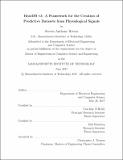BeatDB v3 : a framework for the creation of predictive datasets from physiological signals
Author(s)
Rivera, Steven Anthony
DownloadFull printable version (683.4Kb)
Alternative title
BeatDB version three : a framework for the creation of predictive datasets from physiological signals
Framework for the creation of predictive datasets from physiological signals
Other Contributors
Massachusetts Institute of Technology. Department of Electrical Engineering and Computer Science.
Advisor
Una-May O'Reilly and Erik Hemberg.
Terms of use
Metadata
Show full item recordAbstract
BeatDB is a framework for fast processing and analysis of physiological data, such as arterial blood pressure (ABP) or electrocardiograms (ECG). BeatDB takes such data as input and processes it for machine learning analytics in multiple stages. It offers both beat and onset detection, feature extraction for beats and groups of beats over one or more signal channels and over the time domain, and an extraction step focused on finding condition windows and aggregate features within them. BeatDB has gone through multiple iterations, with its initial version running as a collection of single-use MATLAB and Python scripts run on VM instances in Open- Stack and its second version (known as PhysioMiner) acting as a cohesive and modular cloud system on Amazon Web Services in Java. The goal of this project is primarily to modify BeatDB to support multi-channel waveform data like EEG and accelerometer data and to make the project more flexible to modification by researchers. Major software development tasks included rewriting condition detection to find windows in valid beat groups only, refactoring and writing new code to extract features and prepare training data for multi-channel signals, and fully redesigning and reimplementing BeatDB within Python, focusing on optimization and simplicity based on probable use cases of BeatDB. BeatDB v3 has become more accurate in the datasets it generates, usable for both developer and non-developer users, and efficient in both performance and design than previous iterations, achieving an average AUROC increase of over 4% when comparing specific iterations.
Description
Thesis: M. Eng., Massachusetts Institute of Technology, Department of Electrical Engineering and Computer Science, 2017. This electronic version was submitted by the student author. The certified thesis is available in the Institute Archives and Special Collections. Cataloged from student-submitted PDF version of thesis. Includes bibliographical references (pages 101-104).
Date issued
2017Department
Massachusetts Institute of Technology. Department of Electrical Engineering and Computer SciencePublisher
Massachusetts Institute of Technology
Keywords
Electrical Engineering and Computer Science.
